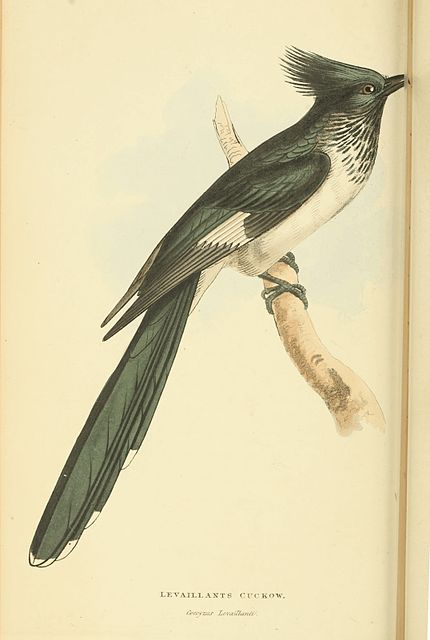Zoological Illustrations Series II/Plate 13
LEVAILLANTS CUCKOW.
Coccyzus Levaillanti
COCCYZUS Levaillantii.
Black and White-throated Cuckow.
Family Cuculidæ.
Generic Character.—Lesson. Man. 2. 120.
Specific Character.
Head crested, the feathers pointed; plumage above black glossed with green; band at the base of the quills, end of the tail, and under parts of the body, white; throat striped with black.
Variete du Coucou Edolio, Le Vail. Ois. d'Af. 4. pl. 209.
Unlike the true Cuckows, the birds of this genus rear and provide for their young in the ordinary manner. The species are numerous in the tropical latitudes of both hemispheres. Two are found in North America, which, in their external characters, approach so near to the genuine Cuckows, that they barely come within the definition of the present group.
It frequently happens that species, originally well described, become involved in obscurity by compilers. Le Vaillant, who first described this bird, supposed it a variety of his Coucou Edolio: but in this he was mistaken; the one being a Cuculus; the other a Coccyzus. We should have thought our species might be the Cuculus Afer. of Drs. Leach and Latham, had not the former stated his bird to be a variety of Le Vaillant's, and figured it as an example of the genus Cuculus. Dr. Latham (Gen. Hist. 3, 290) copies this description of C. Afer. (Zool. Mis. 1. p. 31), adds some further characters not seen in our bird, and, under the same name, describes what is evidently another species. Lastly, M. Vieillot, in his account of the genus Coccyzus (Orn. Ency. Meth. p. 1342), relying on the usual accuracy of Le Vaillant—and never, perhaps, having seen the bird—omits it altogether. To prevent this confusion extending further, and to detach the species from those dubious descriptions with which it has been mixed, we have thought it best to record it by the name of its first describer.
Our figure will render a detailed description unnecessary: the wings, although long, are rounded; the fifth quill being the longest. The total length is fifteen inches. Inhabits Senegal, and the Western Coast of Africa.
